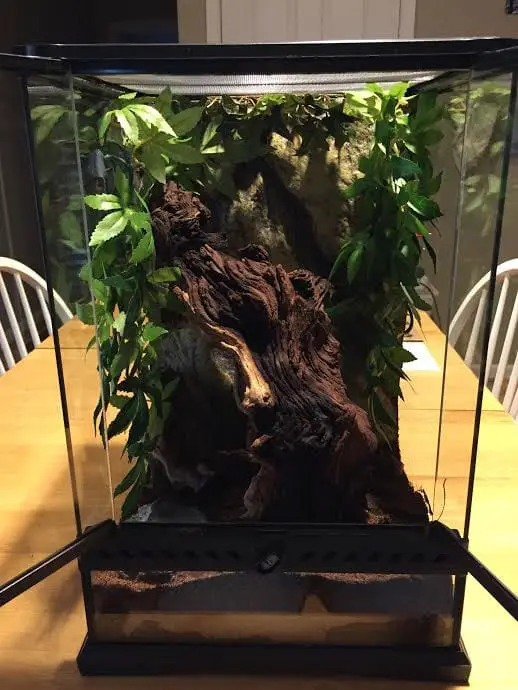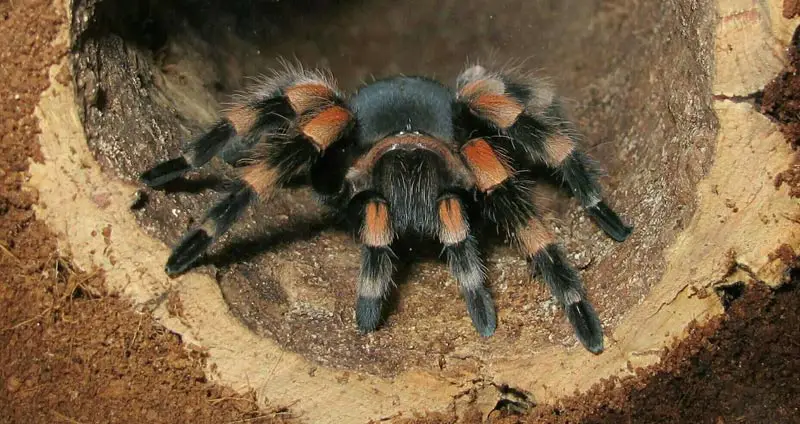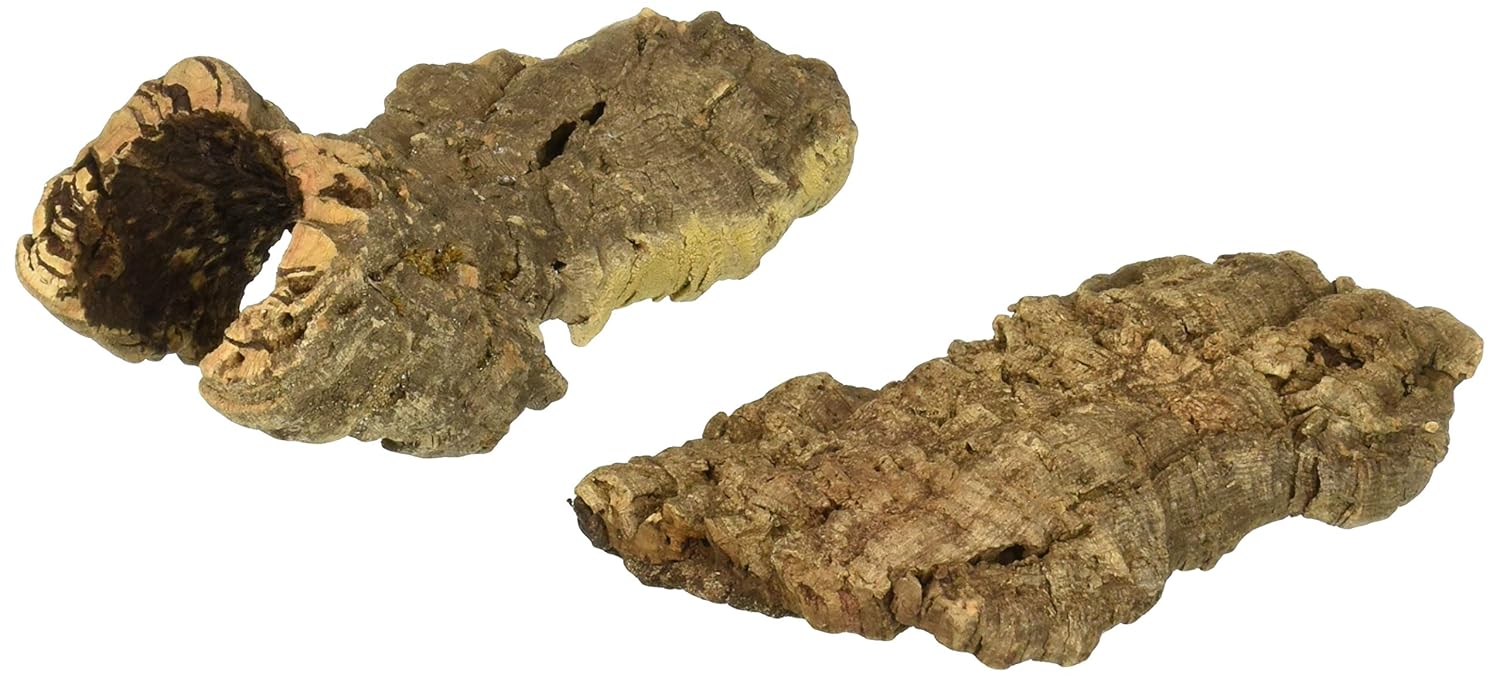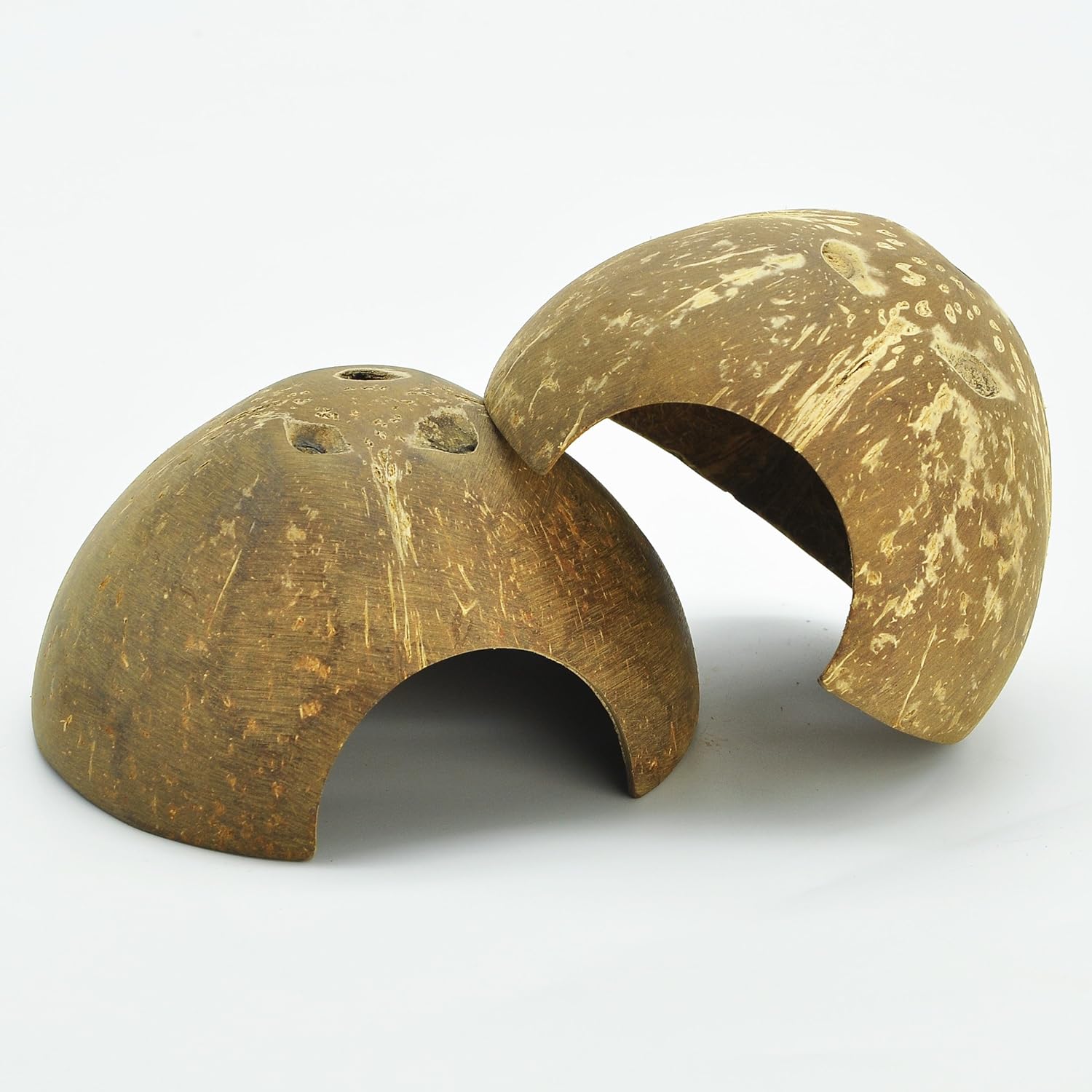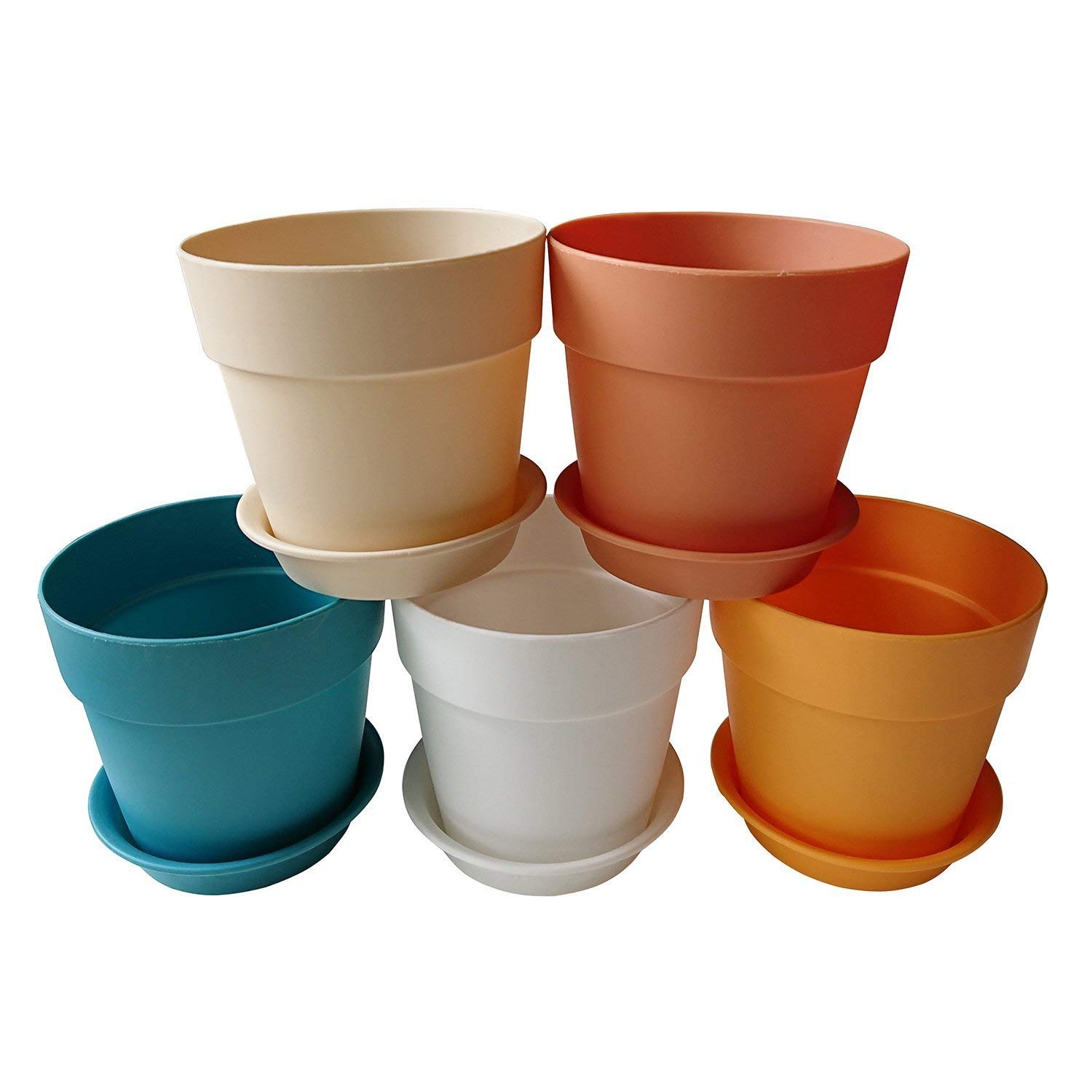While tarantulas may be small creatures that seem simple to take care of, there are certain things that you need to do to ensure their well-being. Those things include proper feeding, routine maintenance, and assuring that their enclosure meets all of their environmental requirements.
There are a few different aspects of a tarantula enclosure, with a tarantula hide being a staple of any enclosure.
This post will go in detail about what exactly tarantula hides are, what they do, why you need one, and how you can either purchase one or make one from scratch. This is an important piece of a perfect pet tarantula enclosure, so be sure that you fully understand the impact of it on your tarantula!
Table of Contents
What Is A Tarantula Hide?
A tarantula hide is essentially what it says in the name — a secure place for a tarantula to hide where they can feed, sleep, or just retreat for a few moments and feel safe.
No matter the size, structure, or look of the hide, its main functionality is to provide a way for a tarantula to isolate itself from the outside world.
The wild habitat of tarantulas is extremely diverse and provides a copious amount of different objects that a tarantula can use to its benefit. There are rocks, bushes, trees, and thousands of other naturally-occurring objects that can act as hides.
A tarantula’s enclosure is much more simple than this and doesn’t have a lot of different places for a tarantula to use as shelter. This is where a hide comes into play.
Benefits Of Tarantula Hides
So what exactly are the benefits of tarantula hides? Tarantula enclosures aren’t necessarily large, so it makes sense that you’d only want to fill it with the essentials. Hides are essential for the well-being of tarantulas, though, so it’s definitely worth making room to fit a hide into your enclosure.
Below are some of the main benefits that hides bring tarantulas.
- Tarantulas can feel more safe and secure – This is the main benefit to tarantula hides. A tarantula enclosure may not provide many spaces for a tarantula to hide and get away from external stimuli. This hide is a permanent, easy-to-access getaway that can provide those benefits and so much more.Tarantulas have developed fine-tuned senses over millions of years of evolution that help them stay away from danger. These senses often result in a tarantula overreacting to little things that you do such as tapping on their glass or even breathing on them. The presence of a hide will help tarantulas to calm down much quicker and get back to their normal selves.
- It adds structure to an enclosure – Not only do hides create a place for tarantulas to feel safe, but they help tarantulas in other ways, too! There’s several ways that a hide benefits the overall structure of an enclosure. First of all, it can placed into the substrate and then a burrow can be dug beneath it. This will help maintain the structure of the burrow and make it more effective.Additionally, if your tarantula is a heavy webber, a hide will provide a great anchor point for their web. Enclosures don’t have many anchor points for webs, so a sizeable hide will allow for a large web to be made with ease.
- It creates a more diverse layout – While tarantulas are relatively simple creatures, they could still benefit from a more interesting enclosure layout than a 12″x12″ plot of substrate. Hides can be burrowed under, climbed on, and built off of. All of these things help to keep an enclosure more interesting and diverse for a tarantula, which any owner will tell you is a massive benefit.
- Enclosures look more interesting – This is more of a benefit for you as the owner since tarantulas don’t really have a knack for design. Regardless, a well-placed and well-designed hide can transform a basic enclosure into something that looks much more natural and put-together. This is especially beneficial for the enclosure of a display tarantula that you’ll be looking at multiple times a day.
Buying Or Making A Tarantula Hide
There are no strict guidelines for how a tarantula hide should look, so there is quite a bit of freedom allotted to you! If you want a more natural-looking tarantula hide, purchasing one from an established website may be your best bet. However, if you’re taking more of a budget approach to your tarantula’s enclosure, there are several different ways that you can create an excellent DIY hide.
Purchasing A Hide
This is the route that many tarantula owners take, and it works excellently for virtually all of them. Store-bought tarantula hides are typically very affordable, look great, and come in a wide variety of different shapes and sizes.
When purchasing a hide, you need to make sure that it’s good quality. If you’re purchasing a hide that’s made of natural materials, there’s the possibility that it could rot or experience other physical. However, if you purchase from a reputable seller with many positive reviews, there’s a good chance that you won’t experience these problems.
Below are some of the most popular commercially-available tarantula hides that would excellently fit into an enclosure.
Half Log Hide
These are extremely popular and common hides that you’ll see in most tarantula enclosures. Half log hides look very natural, are quite durable, and tend to cost only a few dollars.
You can either leave the log flat on the ground to act as a hut, or you can insert it into the substrate at a 45 degree angle to create an overhand over a burrow entrance.
Cork Bark Hide
Cork bark is another popular choice for tarantula hides. This material is durable, natural, and can easily be cut into different shapes so that it perfectly fits into an enclosure.
When you buy cork bark, it tends come in much larger pieces than an enclosure needs. However, just a little bit of handiwork can transform it into the perfect shelter for any size tarantula.
Coconut Shell Hide
Made from the hollowed-out shell of a coconut, these hides bring a more tropical vibe to an enclosure. The thin shell provides much more room for tarantulas to hide underneath it, making it optimal for larger species.
One thing to note about coconut shell hides is that they’re slightly more prone to mold and rot, so be sure that you’re occasionally checking it for signs of decay.
Homemade Tarantula Hides
Although store-bought tarantula hides are relatively cheap considering the utility that they bring, the costs can add up if you’re creating enclosures for several tarantulas. This may encourage you to seek out cheaper alternatives that you can quickly make in your home.
Fortunately, tarantula keepers have gotten very creative in making hides for their tarantulas out of materials that can either be cheaply purchased or are found around their house. Below are some of our favorite creative solutions that keepers have come up with.
Plastic Cups
Some owners, likely the more party-oriented ones, have taken to using disposable plastic cups as an excellent makeshift hide. These are very durable, strong, and sized appropriately for most tarantulas to hide in.
Simply lay the cup sideways and bury about 1/3 of it under the substrate to hold it in place, and boom! You have an excellent makeshift hide.
Plant Pots
This is a slightly more natural-looking hide option if you don’t like the look of solo cups in an enclosure. Plant pots are available in an endless supply of different shapes and sizes, meaning that you can find the perfect one for your tarantula.
Their durability also means that they’ll last forever, so it’ll help save you money in the long run, too.
Molded Clay
Some of the more artistically-inclined keepers have taken to molding their own tarantula enclosures. Pottery clay can be sculpted into the perfect hide and then fired for a structure that will withstand any abuse a tarantula can put it through.
How To Incorporate A Hide Into An Enclosure
There are many different kinds of hides that you can use for your tarantula’s enclosure that encompass all styles and price points. However, you may still be wondering how exactly you can best incorporate the hide into the enclosure. Fortunately, tarantula keepers are very good at sharing all of the creative solutions that they come up.
Looking at these existing enclosures will help give you inspiration on how to create the best hide possible for your tarantula.
Terrestrial Enclosure Hides
Terrestrial tarantulas are spiders that spend most of their time either on the ground or within their burrow. They very rarely, if ever, climb the sides of their enclosure. Because of this, their hides need to be on the ground and resemble a type of cave. Below are 3 examples of terrestrial hides that more than meet the needs of the tarantulas that they’re for.



EulersK’s N. coloratovillosus in its terra cotta plant pot hide. It was broken in half so that it would better fit into the enclosure.
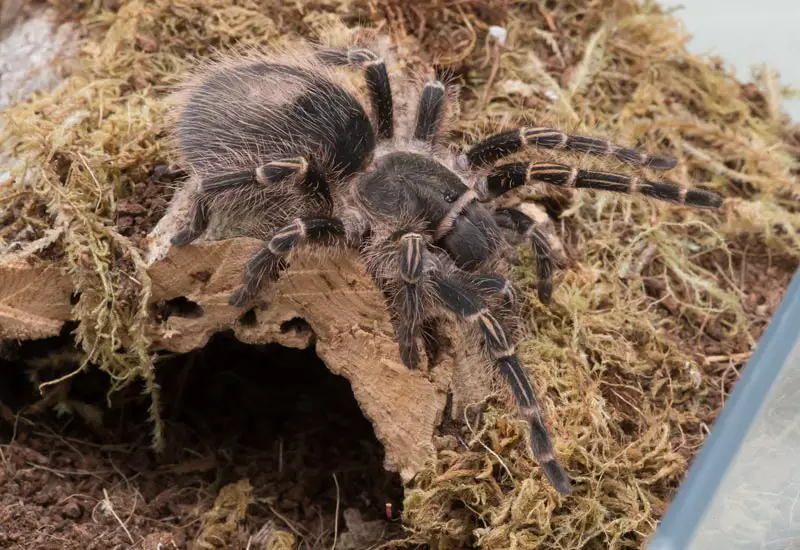


Haemus’s G. pulchripes lounging on top of its cork bark hide. It’s made of a cork bark round that’s been cut in half to better create a shelter.
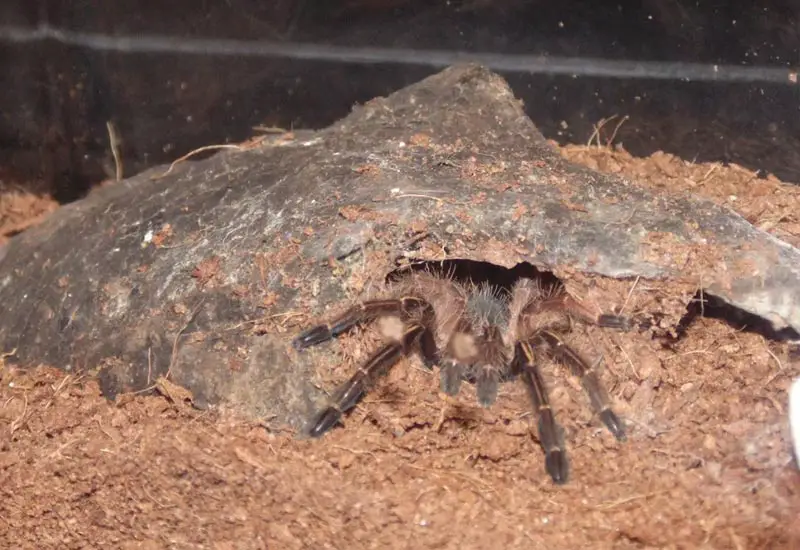


jpiteira’s E. murinus sling emerging from its rock hide. This is a very natural-looking hide that’s relatively small in order to make it feel safe and secure for the smaller sling.
Arboreal Enclosure Hides
Arboreal tarantulas spend most of their time up in the air, naturally living in trees or on different natural structures. Within an enclosure, these tarantulas mostly hang out on the sides of their enclosures, typically around fake vines and plants.
Since these tarantulas find comfort in being in the air, their hides need to be suspended in some way so that they can still be in their comfortable position but stay hidden. Fortunately, this isn’t difficult to do, and can be as simple as leaning a piece of cork bark against the wall of an enclosure. In fact, there’s not much else that you can do for this!
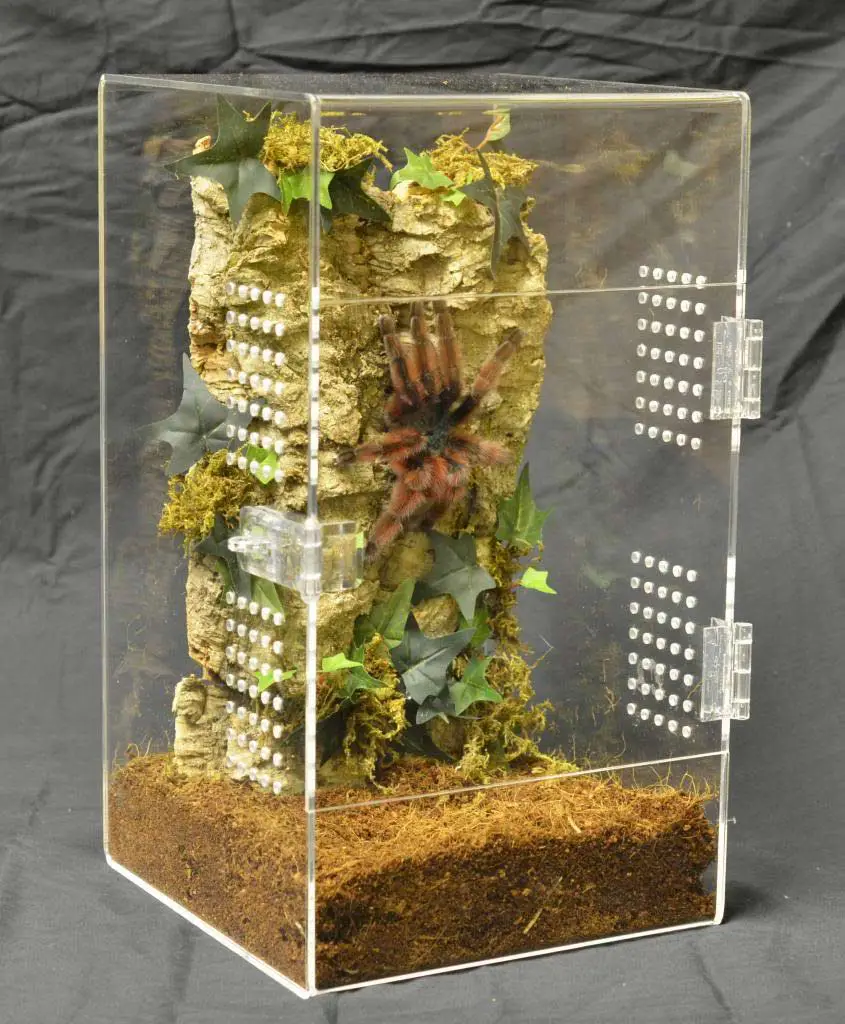


Jamie’s Tarantulas’ ideal representation of an arboreal enclosure. A large piece of cork bark has been stood against the back of the enclosure and covered in sphagnum moss and fake leaves.



Tarantula Canada’s representation of an ideal arboreal tarantula enclosure. A long piece of cork bark has been stood up in the back of the enclosure, creating a secluded hiding spot behind it.
